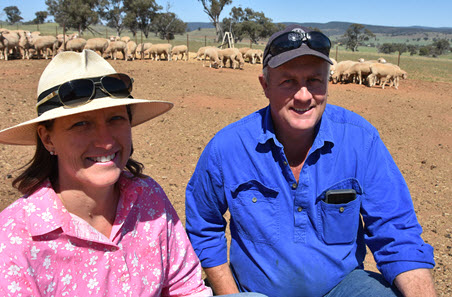Doing it better in dry times
Developing a robust drought feeding regime for their sheep enterprise has laid the foundations for central-west NSW producers Rob and Jude Cooke to lift long-term productivity even further.
Having identified they were under-prepared for a drought and that one was due, the Cookes started developing a drought management plan.

The dry spring of 2017 accelerated progress dramatically.
"We went through what we had in our heads for the management plan with our animal nutritionist, Robert Bell, and he said 'well if you’re talking about building a drought lot, you better do it now’,” Rob said.
Setting up the drought lot
Completed in October 2017, the drought lot (consisting of six pens which can each hold 275 head) is located within walking distance of the sheds and homestead. An initial trial of PVC troughs wasn't successful as they were damaged by the sheep, so they were replaced with concrete troughs and watered by a nearby bore.
The feed ration is administered through self feeders which can be filled direct from the mixer from a central laneway.
Preparing for the worst
A +100mm rainfall event in December 2017 helped with the summer feed situation and left the drought lot empty – but come March, the Cookes were faced with lambs on the ground and no feed in the months ahead.
"2018 provided a unique set of circumstances where, not by choice, three groups of lambs this year have been finished on a a grain based ration.
Traditionally, lambs are left on the ewes for as long as possible – even up to 30kg – but in 2018, the February drop lambs were weaned in three lots by the end of May at an average of 12kg.
Preparation began with the ewes. They were trail-fed in a pasture paddock for three weeks prior to lambing.
Lambs were introduced to grain post-weaning with twice daily bucket feeding, with the ration gradually increasing to 300g/head/day. They were vaccinated and received liquid minerals, administered via the water supply.
For the first 21 days, the emphasis was on setting up lambs and their rumens through a rigid induction process in small paddocks. They were being hand-fed twice a day with a mix of grain, locally-sourced canola meal pellets and ProAgni* ProTect S, a high protein supplement featuring probiotic extract.
* ProAgni was runner up in the 2018 Beef Australia MLA Producer Innovation Award and won the inaugural Beef Australia Pitch in the Paddock competition for their development of the business model which utilises novel organic compounds, including probiotics, to improve feed efficiency and reduce induction time on to a grain based ration.
Boosting lamb survival and feed conversion
"The Protect S was added for three reasons. One, to reduce the risk of acidosis. Two, to ensure the sheep were getting the micro and macro nutrients they needed and three, to improve feed efficiency," Rob Cooke said.
Once on the self feeders, the ratio evolved to wheat, canola meal pellets, cereal hay and ProAgni ProTect S.
The result was minimal loss of lambs – less than 0.2% – and lambs which had a feed conversion ratio of average 3.2–3.5:1. The feed cost was 19c/head/day.
The earliest lambs were sold in August at 42kg (20kg carcase) for $156.80/head, 80 days post-weaning. The second sale was in October at an average of 48kg (23.5kg carcase) for $202 and the last lot were sold in late October at 60kg (29.4kg carcase) for $230/head.
Robert Bell calculated the total cost of feeding was 60c/kg, accounting for labour, overheads and machinery use and depreciation.
Benefits for cull ewes
Inspired by the results and the simplicity of the drought lot operation, which is managed by employee Glenn Haynes, Jude crunched the numbers on improving the condition of five to seven-year-old cull ewes.
The first lot were sold in the yards straight from the paddock for $12/head.
The remainder were moved into the drought lot and fed a lower cost ration where the canola meal pellets were replaced with urea and the straw intake was increased. After 42 days, they were sold for $103/head.
"To make a $65.80/head gross return after $25.20 in feed costs plus labour in six weeks is not a bad return," Rob said.
Lessons learned
Robert Bell said the strategies employed by the Cookes have demonstrated how to lift an enterprise's carrying capacity by focusing on optimum ewe lactation, early weaning and good rumen set up for feed efficiency.
"Rob and Jude have gone from producing 97kg of meat/ha/year to 300kg/ha/year in just five years," Robert said.
Increasing productivity has been a key focus for Rob and Jude, who've implemented a business plan for a resilient and flexible enterprise which meets their business, lifestyle and environmental goals.
To build knowledge, the couple undertook any livestock and farming training available, including MLA's Bred Well Fed Well, and sought out advisors on agronomy, animal nutrition and business.
Their top tips for drought lot success include:
- Plan ahead in the good times by purchasing hay and feed grain at lower prices and storing it for later use.
- Choose your supplements wisely. The Cookes are running an antibiotic and ionophore-free feeding regime in preparation for meeting future supply chains which will seek these guarantees.
- Take a preventative and proactive approach to animal health.
- Set up the drought lot in repeatable modules so it can be replicated and expanded easily (producers can operate a drought lot for up to 4,000 head before needing full planning permission in NSW).
More information
Rob and Jude Cooke



